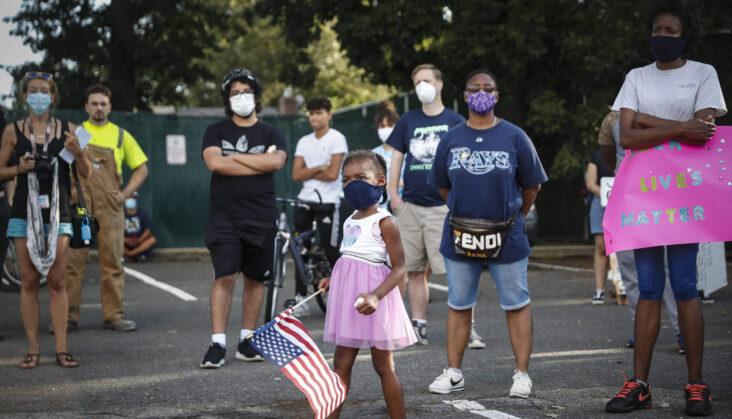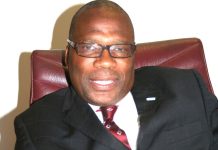Africa-Press – Lesotho. In 1955, James Baldwin wrote in ‘Notes of a Native Son’ that: “People who shut their eyes to reality simply invite their own destruction.
” In his book, Baldwin described the constant threat of explosion that hangs over the United States.
Forty-five years later, America still does not look itself in the face, gnawed from within by a virus far worse than COVID-19: the virus of racism that is destroying the country from within.
All men are created equal; they are endowed by the Creator with certain inalienable rights; among these rights are life, liberty and the pursuit of happiness proclaimed the Declaration of Independence of July 4, 1776.
Nothing about slavery. But the South and their sacrosanct right of ownership over ‘negroes’ should not be overlooked; hell was on earth for a great number of men and women who were still not considered equal to whites, but submissive, tortured and traded.
At the beginning of the Civil War (1861-1865) our bodies were worth 4 billion dollars, more than all American industry (…) and the excellent product created by our stolen bodies – cotton – was America’s main export resource, writes Ta-Nehisi Coates in his book ‘A Black Wrath : Letter to My Son’.
In the aftermath of the end of slavery, the Southern states passed a series of laws and regulations that institutionalised racism (Jim Crow laws). These laws were in effect for almost a century and they prevented blacks from attending the same businesses, institutions, and schools as whites.
They also prevented blacks from owning property. Newly emancipated black farmers were forced by violence, necessity, or deception to sign abusive contracts requiring them to work the land for a share of the harvest under conditions that maintained the control applied by white planters and supervisors before the Civil War.
Black farmers were forced to take out high-interest loans to buy necessities at excessive prices and were only allowed to grow the chosen cash crop. Families were generally unable to pay off the season’s debt, which was carried over to the following year, trapping tenant farmer families in an inevitable debt cycle.
Cruel irony. In 1865, the northern general Sherman promised to bequeath 40 acres of land to freed slaves and a mule (40 Acres & A Mule).
These promises made under Abraham Lincoln’s presidency were revoked by his successor President Andrew Johnson. In fact, filmmaker Spike Lee named his production company after this unfulfilled promise. That moment just after slavery set in motion an institutionalised and accepted form of racism.
Back in 1921, the Tulsa Massacre took place on 31 May and 1 June when white mobs attacked black residents and Greenwood businesses in Tulsa, Oklahoma.
The prosperity of this black neighbourhood earned it the name Black Wall Street…and much jealousy. The Greenwood neighbourhood was burned to the ground.
A hundred businesses, more than a thousand homes, several churches, a school and the only hospital for blacks were torched to ashes. The violence forced more than 10,000 people out onto the streets and caused an estimated $2 million in damage ($32 million in 2020).
Black Wall Street was not compensated. The history of this tragedy would be erased from the collective memory for several decades. A simliar occurence took place in the 1970s when many black families moved to what were traditionally all-white neighbourhoods in Rosedale, Queens, in New York.
These families also encountered hostility and violence. Fastforward to the the 21st century where 24% of all people killed by the police in 2019 were black, even though they represent 13% of the American population. In addition to physical violence, we must add social and economic violence. Tackling the racial issue must be an economic matter.
According to a McKinsey report published in 2019, if the racial wealth gap were closed, the country’s GDP could increase from 4% to 6% by 2028, resulting in an increase in GDP per capita of $2,900 to $4,300.
The colossal impact of inequalities wreaks havoc on the health of the economy. This study makes us aware of the problem and perhaps also offers us a solution: to build an economy that is thought out and calibrated to allow these inequalities to disappear. There is an urgent need to reduce the wealth gap between blacks and whites.
According to the think tank Economic Policy Institute, the average income of white households in 2018 was $70,642 compared to $41,692 for black households.
In February, before the pandemic, the unemployment rate was 5.8% for black people against only 3.1% for white people. The information that inequalities are creating a disastrous impact on the economy may help put an end to the laissez-faire attitude as illustrated by these figures:
In 2012, at Columbia University’s graduation ceremony, President Barack Obama told students: “Fight for your seat at the table. Better yet, fight for a seat at the head of the table.
” Change is a collective responsibility.
Beyond the Black Lives Matters movement, we also see a new generation of American political figures such as Alexandria Ocasio-Cortez or Ilhan Omar working for greater social inclusion.
This new generation, armed with social media and a surer voice is an opportunity to propose a new way of thinking about the collective and to prepare it for change. How can we do this?
In France, as early as 1960, the Mouvement contre le Racisme et pour l’Amitié entre les Peuples (Movement against racism and for friendship among people, MRAP) organised a colloquium on the theme ‘How to teach fraternity?’ where it was decided that there was a need “to protect children before they enter social life against a ‘virus’ (racism) which they will inevitably encounter [and of which] they will be contaminated without defending themselves against it.
Thus, the main solution to the problem of inequality would be to consider as fundamental the question: how should society take shape? This question reformulates both the problem of social integration and that of the articulation between the micro and macroeconomic levels.
This change must be organised and must be the foundation of our nations, when they realise the major economic interest in working around this issue of inequality.
Finding the ‘carrot; that will trigger the right levers for action is indispensable. Referring back to the McKinsey report, the median family wealth in the US has increased from $83,000 in 1992 to $97,000 in 2016.
However, over the same period, the gap in racial wealth between black and white families increased from about $100,000 in 1992 to $154,000 in 2016, partly because white families gained more wealth (with the median increasing by $54,000), while the median wealth of black families remained stagnant over the same period.
It is high time that this changed and created real equality in the economy. I hope that the coming election in November will be an opportunity to reflect on this issue, for all of us.
Indeed, let us not forget that there is only once race: the human race. And as Lord Tennyson said in his poem Ulysses: “Come, my friends, it is not too late to seek a new world.”
For More News And Analysis About Lesotho Follow Africa-Press






